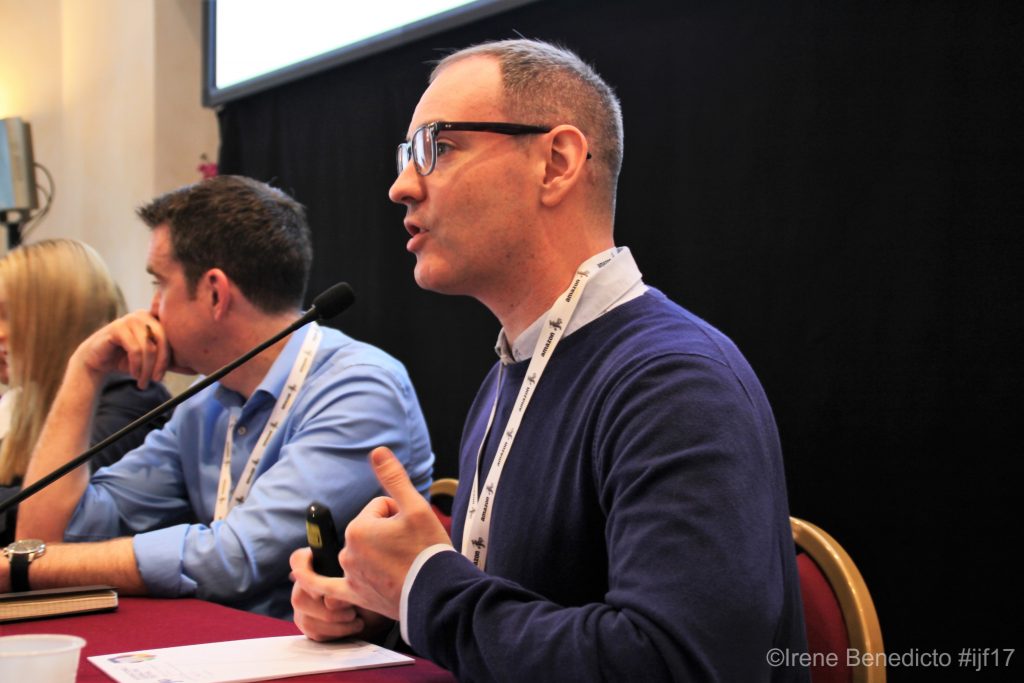
Fake News, like a wild fire, has aggressively spread across the web over the last years, and it has become even more visible in the past months. It has viciously announced its presence within society and has presented itself as an enemy of the media and an (even bigger) enemy of the people who consume news, particularly online. News organisations have had to deal with a lot of crisis, but for the first time ever, the media finds itself forced, to some extent, to compete with the websites that are publishing fake news.
The panel discussion on Fake News and the misinformation ecosystem opened the second day of the International Journalism Festival 2017 edition. The panel consisted of Claire Wardle, Director of research and strategy at First Draft News, Aine Kerr, Manager global journalism partnerships Facebook, Mark Little, Journalist and founder of Storyful, Alexios Mantzarlis, The Poynter Institute, and Craig Silverman, Media editor at Buzzfeed News.
Misinformation is harmful to news consumers, and is as dangerous as an epidemic as it spreads false information with the intention to mislead, deceive and lie to all in the name of a clickbait. Prominent examples of Fake News are celebrity death hoaxes that set social media users on an emotional roller-coaster as they worry that their favourite celebrities died. The unfortunate tale of Fake News is that it is often shared at a higher rate and faster pace than factual news, which makes it then perceived to be the “truth”. This perception can lead to severe consequences.
Wardle begins the discussion with an assertion that Fake News is a global crisis and that “we are all part of this problem”. She went on to say that the term “Fake News” should not even be used during the panel discussion and told the audience to actually stop talking about it and to begin asking themselves what role they are going to play in fighting this “global information pollution”.
Wardle states that this is not something that Trump invented but rather that he “put the spotlight on it”. It is difficult to forget the White House press conference where the President of the United States, Donald Trump, who at the time was President-elect, spoke four words that would get the world talking: as CNN reporter Jim Acosta tried to ask him a question, Trump shut him down hurling “You Are Fake News”. The irony of President Trump is that he has on certain occasions tweeted fake news to his millions followers on twitter.
Little says that the problem is not only about the supply of misinformation, it is also about the demand of the misinformation ecosystem. He says that the difference now compared to some years ago “is the collapse of the means of production of the news that we understand” (i.e. radio and TV). He speaks of how Storyful kicked off with the aim to verify user-generated content, and now serves as a means of battling misinformation and fighting back to those who distribute Fake News by collaborating with fact checkers.
Little raises the point that social media sites, mainly Facebook, has in some ways served as a dominant tool for those who are spreading misinformation and says that it “is a fundamental problem”. He states that we are currently living in times of mistrust where people don’t believe anything anymore because they are subject to an information overload. As a result, journalism finds itself in a pipeline where it makes it harder for the people to distinguish between fake news and real news, and this is why models such as Storyful are important for journalism.
Over the past eight months, Silverman has been researching websites whose main purpose is to distribute misinformation, and through his research he has discovered over 100 sites dedicated to fake news. He says that these websites are driven by ads on their sites and their motive is economical. He says that although some governments are working on fining websites that don’t remove fake news, the problem will most likely never go away because people will always exploit new platforms, for what he calls a “classical act of spam”.
Mantzarlis added that Fake News is indeed usually not politically motivated but rather financially motivated and that, before the term was misused by Trump, it had been misused by journalists. He goes on to say that Facebook gets a lot of criticism concerning this phenomenon because it is a social media platform where Fake News can be measured in terms of analytics and given that it can be seen how many of the Fake News websites were accessed through Facebook. Mantzarlis briefly presented Poynter, a fact checking network that focuses on combating this problem.
Kerr commented that Facebook is aware of the issue and feels deep responsibility for how people use their platform; creating informed and engaged communities is the core mission of Facebook and Fake News clearly counter this mission. She mentions that Fake News is complex and as a result Facebook will need to have innovative solutions to deal with it. She also announces that Facebook a News Integrity Initiative joint with Cuny, and that it is working to identify spoof domains.
The media now more than ever finds itself in a war that they did not quite anticipate or fully prepare for. It is fighting twice as hard to regain news consumers’ trust. News organisations are enabling consumers to distinguish news that is real from news that is fake through various verifying tools however the phenomenon of fake news is still very much alive and kicking. It remains a challenge for the media as they battle with it in the misinformation ecosystem.